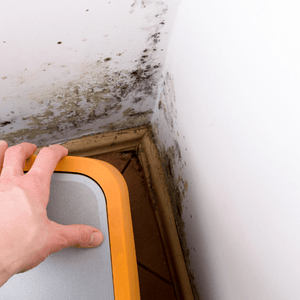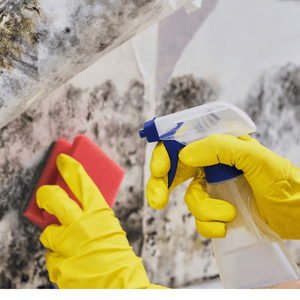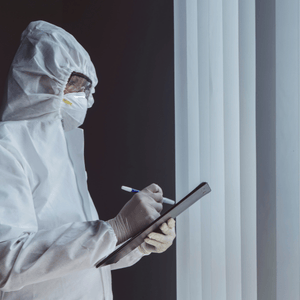When it comes to homeownership in Austin, you’ve probably tackled your fair share of challenges—maybe a leaky roof, a stubborn AC unit, or the occasional unwelcome guest (looking at you, fire ants). But there’s one intruder that’s particularly sneaky and potentially dangerous: black mold.
It doesn’t knock, it doesn’t send an RSVP, and before you know it, it’s taken up residence in your walls, your HVAC system, or even under your floors. The good news? You don’t have to let it stay. At All Nation Restoration, we’re here to help you spot, eliminate, and prevent black mold from becoming a big problem.
Let’s dive into the signs, solutions, and steps you can take to keep black mold far away from your home or business.
Recognizing Signs of Black Mold
What Does Black Mold Look Like (and Where Does It Hide)?

Black mold doesn’t always come with a neon sign pointing to it. In fact, it loves to hang out in hidden, damp spots where you’re least likely to notice. If you spot dark, patchy stains on walls, ceilings, or floors, you might be looking at black mold. It can appear slimy or dry, depending on how long it’s been there.
Common hiding places include:
- Bathrooms, especially around showers or under sinks.
- Basements or crawl spaces with high humidity.
- Behind drywall, particularly after water damage.
- HVAC systems where condensation can collect.
We once helped a family in Round Rock who noticed strange black patches forming behind their fridge. Turns out, a small leak had been quietly feeding mold for months. If you see anything similar, don’t wait—mold spreads fast!
Read more: How to Prevent Moldy Appliances
Musty Odors & Other Warning Signs of Black Mold
Black mold doesn’t always make a grand entrance. It often hides in the shadows, making it crucial to recognize the subtle clues it leaves behind. Here are the most common warning signs:
- Earthy, Musty Odor: If you notice a persistent musty smell in a specific area of your home or business, it could be a sign of hidden mold growth. Don’t ignore it—this natural “nudge” is often one of the first indicators that mold is lurking out of sight.
- Unexplained Health Symptoms: Watch for symptoms like:
- Sneezing and coughing
- Itchy, watery eyes
- Persistent headaches or fatigue
- Worsened allergies or asthma attacks These health issues might seem unrelated at first but could be your body’s reaction to mold exposure.
- Visible Clues: Black mold often leaves dark, patchy stains on walls, ceilings, or floors, especially in damp areas like bathrooms, basements, or near HVAC systems. If you spot these signs, act quickly—mold spreads fast.
Battling Black Mold: Effective Solutions
When to DIY and When to Call the Experts
Here’s the deal: small mold spots (less than 10 square feet) can sometimes be tackled with household cleaning products and some elbow grease. However, handling black mold requires careful attention to safety and technique. Here’s a step-by-step guide for DIY mold cleanup, when it’s safe to do so.
DIY Black Mold Cleanup Process

Step 1: Gear Up for Safety
Mold spores can be harmful, so protecting yourself is essential. Before starting, make sure you have the following safety gear:
- N95 or higher-rated respirator mask.
- Protective goggles without ventilation holes.
- Long rubber gloves that extend past your wrists.
- Long-sleeved shirt and pants that can be washed immediately after.
Step 2: Contain the Area
- Seal off the area with plastic sheeting and tape to prevent mold spores from spreading.
- Close all doors and windows in the room and turn off HVAC systems to limit airflow.
- Use an exhaust fan to direct air outdoors if possible.
Step 3: Prepare Your Cleaning Solution
- Use one of the following recommended products for mold cleanup:
- Commercial Mold Cleaner: Found in most home improvement stores.
- DIY Bleach Solution: Mix one cup of bleach with one gallon of water. (Do not mix with other chemicals.)
- Vinegar: Full-strength white vinegar is effective for killing mold.
- Hydrogen Peroxide: Use 3% hydrogen peroxide in a spray bottle.
Step 4: Scrub the Mold Away
- Spray the cleaning solution generously onto the moldy surface.
- Let the solution sit for at least 10–15 minutes to penetrate and kill the mold.
- Use a scrub brush or sponge to remove the mold. Rinse the area with clean water and dry it thoroughly with a clean towel.
Step 5: Dispose of Contaminated Materials
- If the mold has penetrated porous materials like drywall, carpet, or insulation, these items may need to be removed and replaced.
- Double-bag contaminated items in heavy-duty trash bags and dispose of them immediately.
Step 6: Ensure the Area Is Completely Dry
- Use fans, dehumidifiers, or open windows to dry the area thoroughly.
- Check back over the next few days to ensure no moisture or mold returns.
Safety Precautions
- Avoid Mixing Chemicals: Never mix cleaning products (like bleach and ammonia) as they can produce toxic fumes.
- Ventilate Properly: Even with safety gear, ensure good airflow to minimize exposure to fumes.
- Protect Against Spores: Avoid disturbing moldy materials excessively, as this can release spores into the air.
When to Call the Professionals

While small, surface-level mold can often be addressed on your own, there are situations where professional help is essential:
- Mold Covers a Large Area: If the mold growth is larger than 10 square feet, it’s safer to call in experts.
- Hidden Mold: Mold behind walls, under flooring, or inside HVAC systems requires specialized equipment to locate and remove.
- Severe Water Damage: If water damage caused the mold and structural elements may be affected, professionals can assess and repair the damage.
- Health Concerns: If you or anyone in your household has respiratory issues, allergies, or a compromised immune system, leave the cleanup to certified professionals.
- Recurring Mold Problems: If mold keeps coming back despite your efforts, it may indicate a persistent moisture issue that needs expert attention.
Black Mold Remediation Process Step-by-Step
If you’re curious about how professional remediation works, here’s a quick overview of what we do:
- Inspection: We identify the type and extent of the mold problem.
- Containment: To prevent spores from spreading, we seal off the affected area.
- Removal: We safely remove the mold using specialized equipment.
- Cleanup: We sanitize the area and ensure no traces of mold remain.
- Prevention: We address the moisture issue to stop mold from returning.
The Hidden Costs of Ignoring Black Mold
Ignoring black mold doesn’t save you money—it costs you more in the long run. Left untreated, it can:
- Damage your walls, flooring, and furniture.
- Lower your property value.
- Lead to expensive repairs if it spreads to structural elements of your home.
One of our clients in Cedar Park delayed calling us after spotting mold in their guest bathroom. By the time we arrived, the mold had spread under the tile, requiring a complete bathroom renovation. Don’t let it get to that point—act quickly!
Staying Ahead: Preventing Black Mold Growth
Moisture Control 101: Keeping Your Property Dry
Moisture is black mold’s best friend, so cutting off its water supply is key. Here are a few tips:
- Fix leaks immediately, whether they’re from pipes, roofs, or appliances.
- Use exhaust fans in bathrooms and kitchens to reduce humidity.
- Keep indoor humidity levels below 50% by using dehumidifiers.
Regular Inspections: Your Best Defense Against Mold
Make it a habit to inspect your property regularly for leaks, water damage, or musty odors. Check areas prone to moisture, like basements, attics, and around windows.
Pro tip: After heavy rains or storms (and we’ve had plenty here in Austin), give your roof and gutters a quick check to make sure water isn’t sneaking in. Read more: Water Damage and Mold Signs After Heavy Rains
Building Materials That Fight Back
If you’re renovating, consider mold-resistant materials like treated drywall, mold-resistant paint, and moisture-proof insulation. These products might cost a bit more upfront, but they can save you a fortune in the long run.
Why Choose All Nation Restoration for Black Mold Problems?
Local Experts You Can Trust
We’ve been serving the Austin area for years, and we know how our climate contributes to mold problems. Whether you’re in Pflugerville, Kyle, or right in the heart of Austin, we’ve got your back.
We’re More Than Cleanup: We’re Your Partners in Prevention
Our job doesn’t end with removing mold. We work with you to create a prevention plan tailored to your home or business, so you don’t have to deal with mold again.
Take Action Against Black Mold Today
Black mold isn’t something you can ignore or hope will go away on its own. The sooner you address it, the easier and cheaper it is to resolve. Whether you’re dealing with a small patch in your bathroom or a major infestation in your office, All Nation Restoration is here to help.Call us at (512) 887-6887 or click here to schedule an inspection. Let’s make your home or business safe, healthy, and mold-free—so you can get back to focusing on what really matters.







